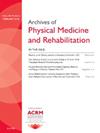Lessons Learned: Counseling and Peer Support for Individuals with Spinal Cord Injury 4362
IF 3.6
2区 医学
Q1 REHABILITATION
Archives of physical medicine and rehabilitation
Pub Date : 2025-04-01
DOI:10.1016/j.apmr.2025.01.035
引用次数: 0
Abstract
Objectives
To understand the background of counseling and peer support. To describe how a program of counseling and peer support was and can be established. To learn barriers and facilitators in implementation of a counseling and peer support program. To summarize lessons learned on implementing a counseling and peer support program.
Design
Longitudinal descriptive qualitative study of reports of the participants who were enrolled in the study over the course of 6 weeks.
Setting
Fitness and Wellness Facility for Spinal Cord Injury Rehabilitation and Recovery.
Participants
Nine participants with spinal cord injury (SCI) volunteered for the study. All participants alternated between individual and group counseling sessions.
Interventions
First a focus group was established of 9 people with SCI in the community who guided the dosage and direction of the topic list needed to lead the counseling sessions. The counselors were social workers who had SCIs and were active in the planning and implement and the planning of the study. Participants were followed for 6 weeks, alternating between individual and group gatherings. The topic list provided ranged from transportation, sex, relationships and more. There were guiding questions began the discussion, which were modified based on the participants’ responses. A qualitative analysis was performed on the notes assembled for all participants (n=9). Program feedback was provided by social workers.
Main Outcome Measures
Qualitative summaries over the 6 weeks for all participants and program evaluation review.
Results
Participants found the in-person meetings useful and wished the program would continue indefinitely. All participants found the group sessions most helpful and reported beneficial engagement with other participants. Several participants who had transportation or health challenges, who were offered a virtual option to continue their participation.
Conclusions
A counseling support program could be generated in most clinical settings with the appropriate expertise such as Social Work or Psychology and is most beneficial in a community setting. This allows individuals with SCI to describe barriers or challenges that could enable a rich discussion and a sharing of possible solutions. It is important that the content of these discussions remain private and only deidentified key issues were available for this analysis. The word “counseling” had a negative connotation so other less imposing terms should be considered. Challenges included the time needed to on-board the counselors into the HR system to be paid, and recruitment/retention, however the virtual option was desirable.
Disclosures
I am the PI on the Perry Grant that funded this study and a Board Member for Motion Project Foundation
经验教训:咨询和同伴支持与脊髓损伤的个人4362
目的了解心理咨询与同伴支持的背景。描述一个咨询和同伴支持的项目是如何建立的。学习实施咨询和同伴支持计划的障碍和促进因素。总结实施咨询和同伴支持计划的经验教训。设计对参加研究的参与者在6周内的报告进行纵向描述性定性研究。设置脊髓损伤康复健身设施。9名脊髓损伤(SCI)患者自愿参加这项研究。所有参与者轮流参加个人和小组咨询会议。干预措施首先,在社区中建立了一个由9名脊髓损伤患者组成的焦点小组,他们指导指导咨询会议所需的主题清单的剂量和方向。辅导员是社会工作者,他们有SCIs,积极参与研究的规划和实施。参与者被跟踪了6周,在个人和团体聚会之间交替进行。提供的主题列表包括交通、性、人际关系等。讨论开始时有一些指导性问题,这些问题会根据参与者的回答进行修改。对所有参与者(n=9)收集的笔记进行定性分析。项目反馈由社工提供。主要结果测量所有参与者6周的定性总结和项目评估回顾。结果参与者发现面对面的会议很有用,并希望该计划能够无限期地继续下去。所有参与者都认为小组会议最有帮助,并报告了与其他参与者的有益互动。一些有交通或健康问题的参与者可以选择是否继续参与。结论在大多数临床环境中,通过适当的专业知识,如社会工作或心理学,可以产生咨询支持计划,并且在社区环境中最有益。这使得SCI患者能够描述障碍或挑战,从而进行丰富的讨论和分享可能的解决方案。重要的是,这些讨论的内容必须保密,只有已确定的关键问题可用于本分析。“咨询”这个词有负面的含义,所以应该考虑其他不那么强烈的术语。挑战包括将辅导员纳入人力资源系统所需的时间,以及招聘/保留,但虚拟选项是可取的。我是资助这项研究的佩里基金的PI,也是运动项目基金会的董事会成员
本文章由计算机程序翻译,如有差异,请以英文原文为准。
求助全文
约1分钟内获得全文
求助全文
来源期刊
CiteScore
6.20
自引率
4.70%
发文量
495
审稿时长
38 days
期刊介绍:
The Archives of Physical Medicine and Rehabilitation publishes original, peer-reviewed research and clinical reports on important trends and developments in physical medicine and rehabilitation and related fields. This international journal brings researchers and clinicians authoritative information on the therapeutic utilization of physical, behavioral and pharmaceutical agents in providing comprehensive care for individuals with chronic illness and disabilities.
Archives began publication in 1920, publishes monthly, and is the official journal of the American Congress of Rehabilitation Medicine. Its papers are cited more often than any other rehabilitation journal.

 求助内容:
求助内容: 应助结果提醒方式:
应助结果提醒方式:


